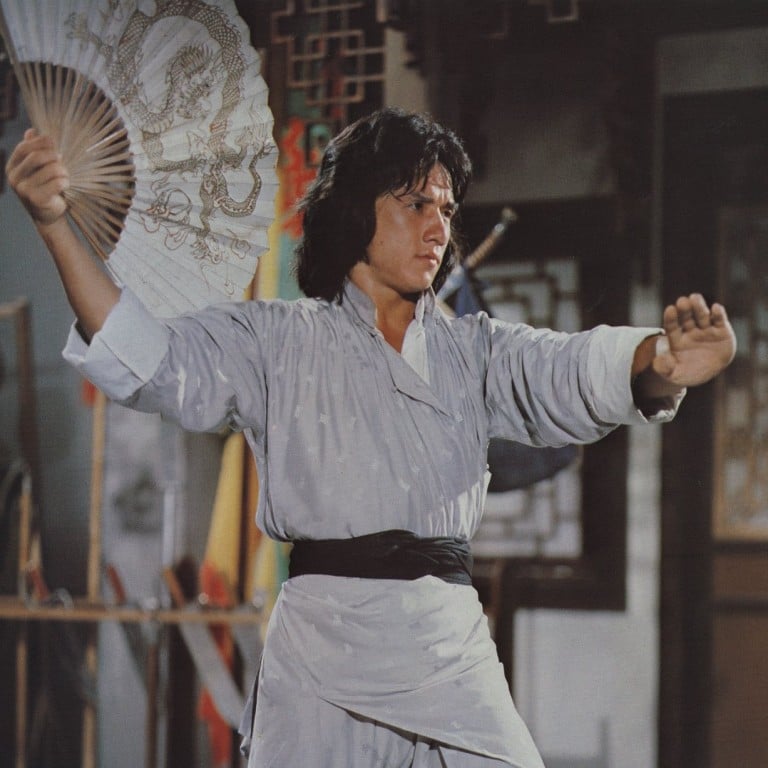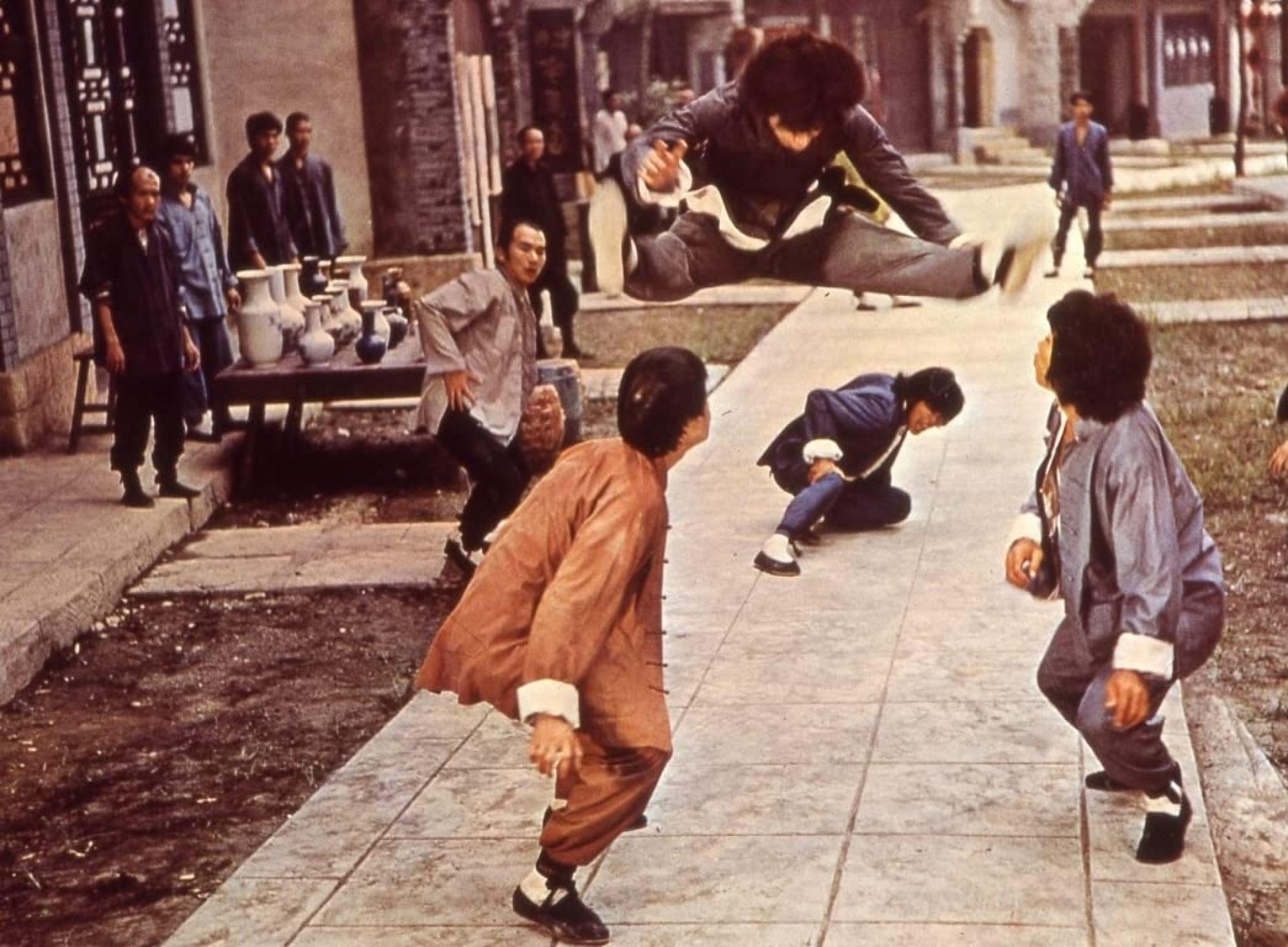
The first Jackie Chan movies: how martial arts superstar shaped his fighting style in Shaolin Wooden Men, The Young Master, and more
- They wanted him to fill Bruce Lee’s shoes, but Jackie Chan quickly understood that wouldn’t work. He honed his fighting style in early films, then stepped up
- Signing for Golden Harvest allowed him to direct, and his first film for the studio, The Young Master, ‘set a new path for Asian films’, Chan later recalled
Jackie Chan’s first shot at fame during the mid-1970s saw Lo Wei, who had directed The Big Boss and Fist of Fury, try to turn him into a Bruce Lee clone. But their first film, New Fist of Fury (1975), failed at the box office.
The kung fu comedies Snake in the Eagle’s Shadow and Drunken Master, both released in 1978, finally put comparisons with Lee to rest. Chan then signed to the Golden Harvest studio, which gave him the resources to direct The Young Master (1980), in which he was able to flex his wings as a director, actor and choreographer.
In this previously unpublished interview from 1998, Chan talked to this writer about the qualities of his early films.
When you made New Fist of Fury, Lo Wei, the director, wanted you to perform like Bruce Lee. How did you react to that?
Bruce knew a lot about philosophy, which he had learned at school, and I don’t have his talent for philosophy. I just know what I am doing, I know my craft.
Also, I had seen the pressure that Bruce had come under because he promoted himself as the best fighter, and I didn’t want to go through that. So I realised that to succeed, I would have to be completely different to him.
Was there anything you liked about New Fist of Fury?
Well, I learned a lot. Lo used to fall asleep when we were shooting the fighting scenes, and when he was asleep, I would do everything myself. When he was asleep, the crew worked quietly so as not to wake him, and I had more time to work the martial arts scenes out. So that really helped me become more experienced.
But I’m not really satisfied with the martial arts in that film. Lo didn’t give me enough time to work out the fighting. It was a low-budget film, and everything happened too fast. He always made me finish the fight scenes very quickly. When the movie came out, it wasn’t a success.
Shaolin Wooden Men, which you made for Lo in 1976, is a much better film. Do you agree?
I am very pleased with the martial arts in that film, as I choreographed them myself. Lo was still trying to turn me into the next Bruce Lee with Shaolin Wooden Men, so the film failed at the box office.
The audience were expecting me to fight like Bruce and I didn’t. Bruce Lee was all northern-style kung fu, and I used a bit of northern style and a bit of southern style. To be honest, I looked completely different to him. I guess the audience just could not accept me after Bruce Lee died.
Bruce was the best as far as they were concerned, and they just could not accept another action star. But although the audience didn’t like it, Shaolin Wooden Men was a big hit with people in the movie industry – they all liked it a lot.
People in the industry started to notice my style for the first time and became interested in what I was doing. The only person that didn’t notice was Lo.

After the success of the kung fu comedies Snake in the Eagle’s Shadow and Drunken Master, you signed with Golden Harvest. Why them and not Shaw Brothers?
Shaw Brothers offered me a lot of money to sign. But I went with Golden Harvest. I just had a feeling that it was the right thing to do. Shaw Brothers had many stars, perhaps too many, so I thought that if I signed to Golden Harvest, I would have a better chance to stand out.
Golden Harvest knew that I was speaking to Shaw Brothers in the morning and Golden Harvest in the afternoon, so they told me they would make me a star in America, to get me to sign.
I told Shaw Brothers that Golden Harvest wanted to make me an international star, and asked them if they would do that. Shaw didn’t have an answer. They had a lot of money, but they hummed and hawed about a lot of things. Golden Harvest just wanted to get me making films fast, so I signed with them.
The Young Master, your first film for Golden Harvest, and your first film as director, is a very strong work.
I remember that I really challenged myself for that film. I had to make it different from the other movies that were successful at that time. I also wanted Golden Harvest to give me enough time to make a good movie.
Other companies made you make films very quickly, and then they released them very quickly. I really didn’t want to do that – I wanted to have time to make a good film. I told Golden Harvest that I didn’t want to rush my first movie for them, and they agreed.
The fight styles of Young Master change as the film goes along. That’s because I was shooting it in order. If you look at The Young Master’s beginning, I had choreographed the fights the same way as everyone else. I noticed that just after I had shot it. So I decided to change the style. When the bad guy comes out, the action style changes. By the end, the style has changed a lot – I’m basically doing street fighting.

That movie set a new path for Asian films, as we had come up with something new. Everybody said: “Look at what Jackie is doing.” There were a lot of good action choreographers in Hong Kong, but they were all busy making many films each year. They had no time to come up with anything new.
All these guys were my friends, and later they told me: “Jackie, you are so lucky to have new ideas, as we have no new ideas.”
I was just doing one movie a year, so I could do it my way and do something new. I started doing it that way with The Young Master, and I have been doing it that way ever since.
In this regular feature series on the best of Hong Kong martial arts cinema, we examine the legacy of classic films, re-evaluate the careers of its greatest stars, and revisit some of the lesser-known aspects of the beloved genre. Read our comprehensive explainer here.
Want more articles like this? Follow SCMP Film on Facebook
